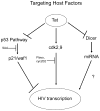Novel HIV-1 therapeutics through targeting altered host cell pathways
- PMID: 19732026
- PMCID: PMC2785118
- DOI: 10.1517/14712590903257781
Novel HIV-1 therapeutics through targeting altered host cell pathways
Abstract
The emergence of drug-resistant HIV-1 strains presents a challenge for the design of new drugs. Anti-HIV compounds currently in use are the subject of advanced clinical trials using either HIV-1 reverse transcriptase, viral protease or integrase inhibitors. Recent studies show an increase in the number of HIV-1 variants resistant to anti-retroviral agents in newly infected individuals. Targeting host cell factors involved in the regulation of HIV-1 replication might be one way to combat HIV-1 resistance to the currently available anti-viral agents. A specific inhibition of HIV-1 gene expression could be expected from the development of compounds targeting host cell factors that participate in the activation of the HIV-1 LTR promoter. Here we discuss how targeting the host can be accomplished either by using small molecules to alter the function of the host's proteins such as p53 or cdk9, or by utilizing new advances in siRNA therapies to knock down essential host factors such as CCR5 and CXCR4. Finally, we will discuss how the viral protein interactomes should be used to better design therapeutics against HIV-1.
Figures

Similar articles
-
Emerging drug targets for antiretroviral therapy.Drugs. 2005;65(13):1747-66. doi: 10.2165/00003495-200565130-00002. Drugs. 2005. PMID: 16114975 Review.
-
Pharmacological cyclin-dependent kinase inhibitors as HIV-1 antiviral therapeutics.Curr HIV Res. 2003 Apr;1(2):131-52. doi: 10.2174/1570162033485339. Curr HIV Res. 2003. PMID: 15043199 Review.
-
Small-molecule antagonists of CCR5 and CXCR4: a promising new class of anti-HIV-1 drugs.Curr Pharm Des. 2004;10(17):2041-62. doi: 10.2174/1381612043384312. Curr Pharm Des. 2004. PMID: 15279544 Review.
-
Inhibition of HIV-1 fusion with small interfering RNAs targeting the chemokine coreceptor CXCR4.Gene Ther. 2004 Dec;11(23):1703-12. doi: 10.1038/sj.gt.3302339. Gene Ther. 2004. PMID: 15306840
-
Recent progress in the development of inhibitors of human immunodeficiency virus (HIV) integrase for the management of HIV infection.Acta Virol. 2008;52(4):197-207. Acta Virol. 2008. PMID: 19143475 Review.
Cited by
-
HIV-1-related factors interact with p53 to influence cellular processes.AIDS Res Ther. 2023 Sep 10;20(1):66. doi: 10.1186/s12981-023-00563-7. AIDS Res Ther. 2023. PMID: 37691100 Free PMC article. Review.
-
Nelfinavir impairs glycosylation of herpes simplex virus 1 envelope proteins and blocks virus maturation.Adv Virol. 2015;2015:687162. doi: 10.1155/2015/687162. Epub 2015 Jan 29. Adv Virol. 2015. PMID: 25709648 Free PMC article.
-
Cellular networks involved in the influenza virus life cycle.Cell Host Microbe. 2010 Jun 25;7(6):427-39. doi: 10.1016/j.chom.2010.05.008. Cell Host Microbe. 2010. PMID: 20542247 Free PMC article. Review.
-
HIV-1 replication and latency are regulated by translational control of cyclin T1.J Mol Biol. 2011 Jul 29;410(5):917-32. doi: 10.1016/j.jmb.2011.03.060. J Mol Biol. 2011. PMID: 21763496 Free PMC article.
-
Cyclosporin A inhibits the influenza virus replication through cyclophilin A-dependent and -independent pathways.PLoS One. 2012;7(5):e37277. doi: 10.1371/journal.pone.0037277. Epub 2012 May 15. PLoS One. 2012. PMID: 22615963 Free PMC article.
References
Publication types
MeSH terms
Substances
Grants and funding
LinkOut - more resources
Full Text Sources
Other Literature Sources
Medical
Research Materials
Miscellaneous
